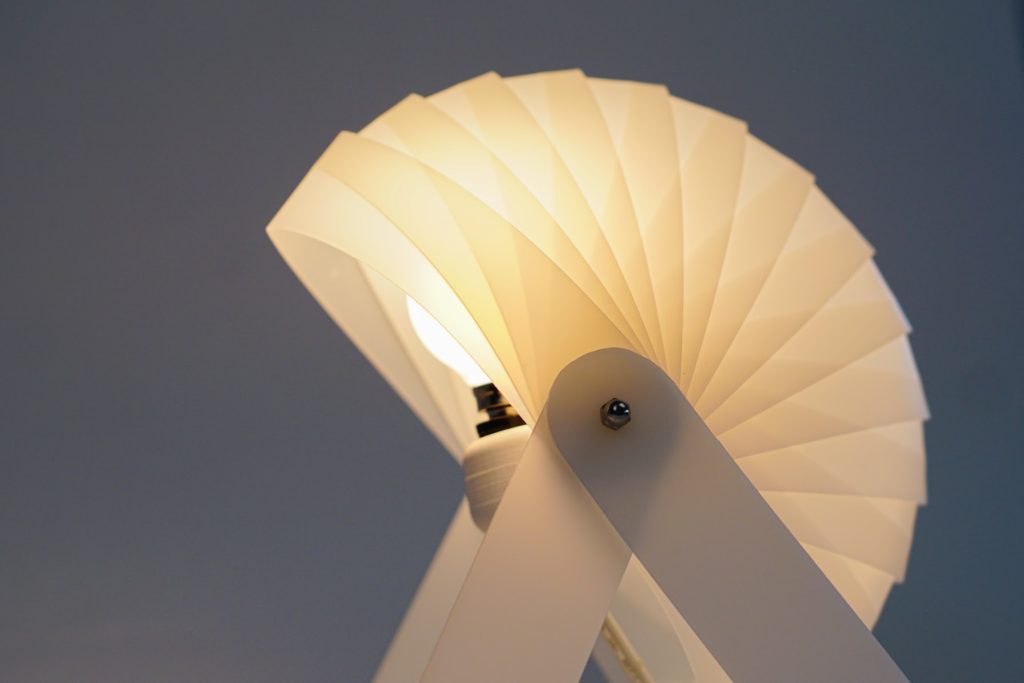Industrial design students create, sell innovative lamps

BYU industrial design students spent the last three months creating unique lamps to sell for their class project.
Each semester, the sophomores in the industrial design program take on a three-month project where they must create a product to sell, with new constraints and design each semester.
This semester’s Illumination Lamp Sale included student-designed lamps that followed certain stipulations: they must have a plug and be made of sheet materials, and the shipping must cost $13 or less.
Because of the pandemic, what was usually a team project became an individual undertaking. Each student was tasked with designing a lamp and making 10 copies to sell online and through an Instagram account.
No one knew beforehand how many lamps they would sell or if they would break even on the costs. The students paid for their materials themselves and get all profits made from the lamps sold.
Industrial design major Bowen Byers said the process of making ten copies of the same lamp taught them mass production skills. “We learned how to make sure it’s the same every time and the quality is the highest possible while it’s just one person making it all,” he said.
The sale was set to end Nov. 18 but was extended because the sale reached a wider audience than ever before. The sale will be open from month to month until the class decides to close it.
Isaac Hiller, another student in the class, said normally the sale is in person and only Provo locals, family members or friends buy the lamps. With the sale online and promoted on Instagram, the lamps have caught the attention of lighting design accounts, design firms, people out of state, and even a green design account who reposted student Addie Payne’s cork lamp.
Professor David Morgan said selling the lamps is an exciting way for students to get feedback and outside validation on their product. “How cool it would be as a student that you make it and sell it. I think that’s very motivating,” he said.





The twist, however, is that the students are told the constraints throughout the semester, forcing them to rely on reinventing, innovating and adapting to the challenge.
Many students said professor Morgan’s “reverse engineered” approach to this assignment helped them be more creative in their lamp designs. Extra instructions for the lamps were given every few weeks, creating new requirements for the students to figure out.
“When I give an assignment, I give it in piecemeal because I am waiting to see how it progresses. I want to see what is happening with the students and be flexible instead of locking us into a schedule or into a certain way of doing it,” Morgan said.
Morgan said this project gives students real-world application as many companies deal with new restrictions or run into problems during the creation process. Rather than hindering the student’s success, this way of creating helps them learn more.
Instead of just focusing on helping the students learn how to make good products, Morgan puts an emphasis on teaching students to understand for themselves what constitutes good products and how to make them logistically. That way, he said they can be better prepared for their future careers.
“It means a lot more to you when you discover it yourself, and my job is to help them see that on their own with a little bit of guidance,” he said.
Morgan praised his students’ willingness to be flexible and stick with the challenge. “There’s not that many students that would play along by going into the uncertainty and have things changed up halfway through without mass rebellion,” he said.
Payne said that although the new instructions were frustrating at times, “the constraints breed creativity.” After getting more instructions during the design process, Payne said she had to change her whole idea for a different lamp.
Although the restraints limit what kind of lamps the students could make, Byers said it taught him to learn a new way of solving the problem. “It’s open-ended. We choose what we do,” he said. “In the ambiguity, we can learn what we personally do and don’t like.”
The finished lamps were all diverse despite the constraints. The sheet material requirement gave students options of aluminum, acrylic, wood, high-density polyethylene, cork and more. From there, the plug, lightbulb, shape, function and overall design were unique to each student.
The sale website has pictures of all the student’s finished lamps.
Grace Barber, a student in the class, said she is grateful classes stayed in person up until Thanksgiving break because this hands-on project would be difficult to complete online. She said while the students had the option to be online or come in person, “it’s notable that every single one of us comes. You have to be fully invested in this.”
The post Industrial design students create, sell innovative lamps appeared first on The Daily Universe.

